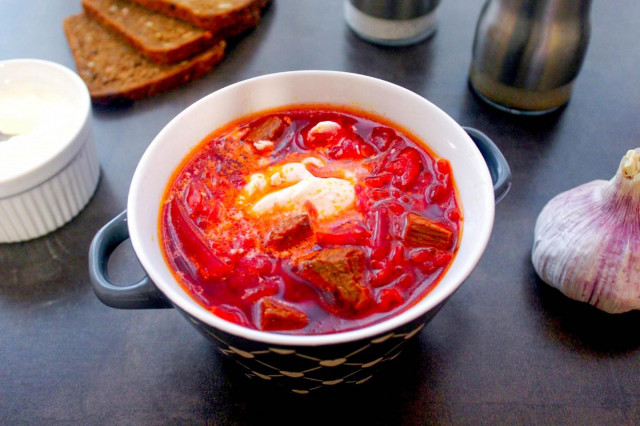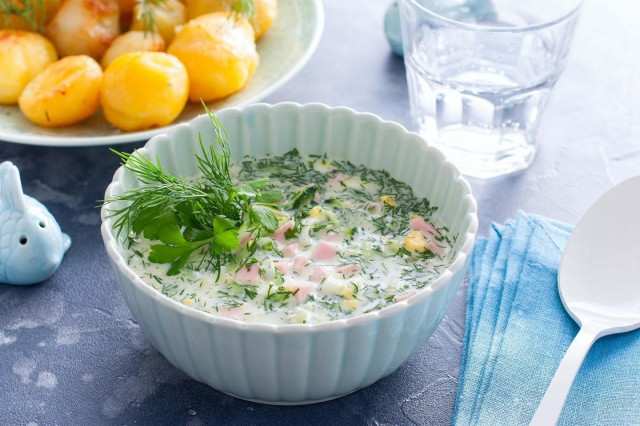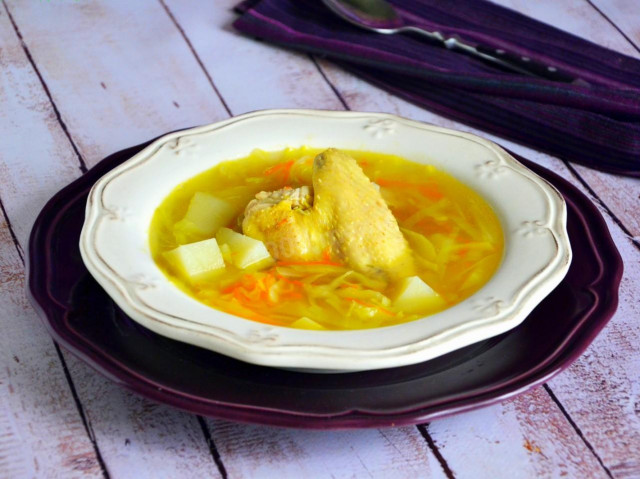Composition / ingredients
Step-by-step cooking
Step 1:
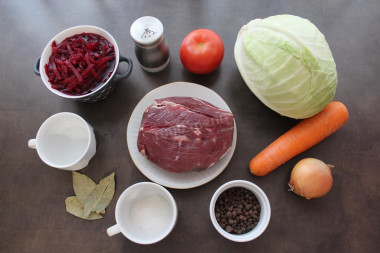
How to cook hot borscht from pickled beets? Prepare the ingredients for making the soup. Beef is better to take on the bones, with a small amount of fat, so the borscht will turn out richer and tastier.
Step 2:
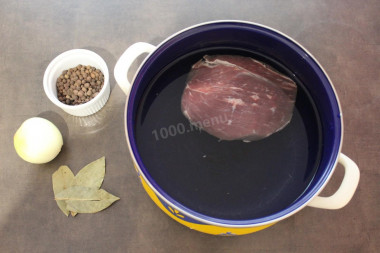
Cook the meat broth. How to cook broth? Put the beef in a large saucepan, cover with cold water and put on fire. When the water boils, reduce the heat to medium and remove the foam from the surface with a slotted spoon. Add the peeled whole onion, bay leaf, allspice peas and salt to the boiling broth. Cook it under a closed lid at a low boil for 1.5 hours. The cooking time may vary, depending on the quality of the meat.
Step 3:
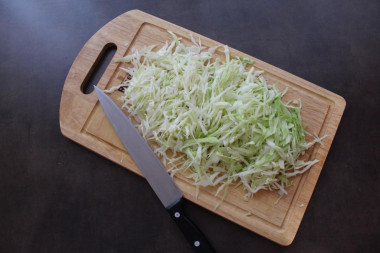
Prepare the vegetables for the soup. Using a sharp knife, finely chop the white cabbage.
Step 4:
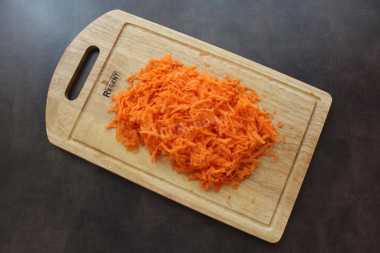
Peel the carrots and grate them on a coarse grater.
Step 5:
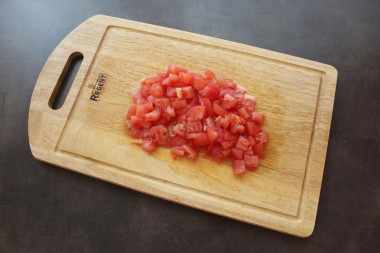
Peel the tomato. How to remove the skin from a tomato? Make a criss-cross incision on top. Put the tomato in boiling water for a minute, then immediately transfer to cold water. From the temperature difference, the skin will easily move away from the pulp. Cut the peeled tomato into small cubes. Tomatoes in this recipe can be replaced with ketchup, tomatoes in their own juice or tomato paste. Choose the proportions to your taste.
Step 6:
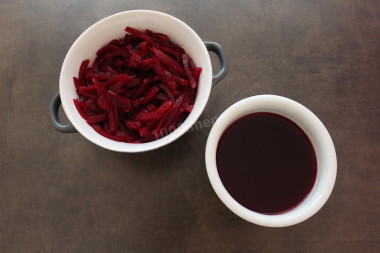
Drain the juice from the pickled beetroot into a small container, put the beetroot itself into another container. In a jar with a volume of 500 grams, the juice was 200 grams, and sliced pickled beets, respectively, 300 grams.
Step 7:
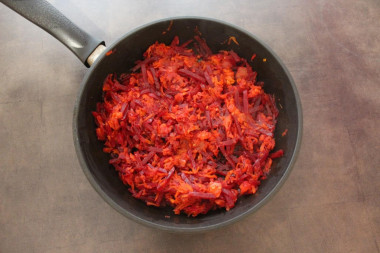
Now prepare the roast for the soup. How to make a roast? Heat the vegetable oil in a frying pan, put the carrots on it, fry it a little over low heat. Then add the chopped tomato and put out the vegetables a little. After 3-4 minutes, add the chopped pickled beets and simmer all together for another 5 minutes.
Step 8:
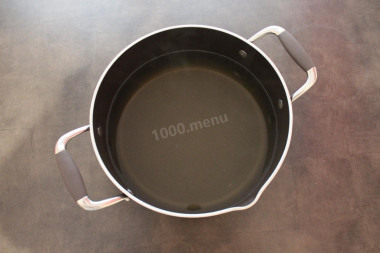
Remove the cooked meat and onion from the broth with a slotted spoon. Using a sieve and gauze, strain the finished broth into a large, clean saucepan. Return the pot of broth to the fire and bring it to a boil again.
Step 9:
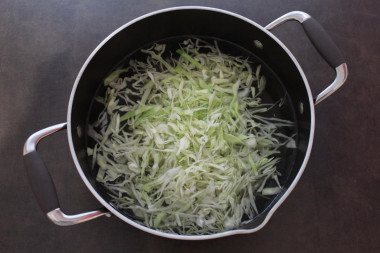
Put the chopped cabbage in boiling broth, cook the soup under the lid until the cabbage is ready, about 10 minutes.
Step 10:
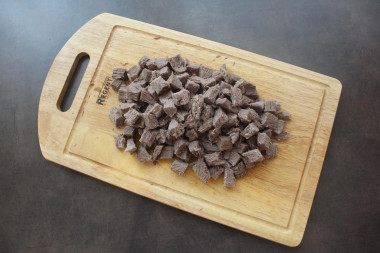
Cut the cooled flesh of boiled beef into small cubes.
Step 11:

When the cabbage becomes soft, add the roast, beef cubes to the pan, add sugar, pour vinegar and juice from the pickled beetroot. Let the soup boil a little more, then turn off the heating and let the borscht brew under the lid for about 15 minutes. Then pour it on plates, add sour cream if desired and serve to the table. Enjoy your meal!
When preparing this soup, I used pickled beets bought at the grocery store. However, such beets can be prepared independently at home, adding spices to your liking. Then both beetroot and marinade will be filled with new flavors.
Important! Regardless of whether the amount of water for soup is indicated in the recipe or not, it is best to focus on your own preferences (thick or more liquid soup you like), as well as on the size of your pan and the products taken for cooking. Do not forget that the author has his own view on the amount of meat, potatoes, cereals and other ingredients in the soup, which may not coincide with yours. In practice, this means that if you are cooking for the first time, you should not cook a whole pot at once. Make a soup for tasting - for one or two people. To do this, reduce the amount of all ingredients according to the recipe to 1-2 servings, and take the amount of water from the calculation: from one cup per serving - if the soup is very thick, to 1.5-2 cups - if more liquid. Do not forget to take into account that part of the liquid will boil off during the cooking process. After tasting a small portion of soup, you can adjust both the amount of liquid and the proportions of ingredients to your taste. In the future, like most experienced housewives, you will be able to pour water for soup and lay the ingredients “by eye".
Beef can be replaced with any other type of meat that you like best. But keep in mind that the cooking time, as well as the taste and calorie content of the dish will change. Pork and lamb tend to be fatter than beef, and chicken fillet or turkey are leaner. At the same time, the cooking time depends not only on the type of meat, but also on which part of the carcass is used and how old or young the meat is.
Root vegetables are best washed with a brush or a hard sponge under running water.
Caloric content of the products possible in the composition of the dish
- Onion - 41 kcal/100g
- Tomatoes - 23 kcal/100g
- Melted beef fat - 871 kcal/100g
- Fat beef - 171 kcal/100g
- Lean beef - 158 kcal/100g
- Beef brisket - 217 kcal/100g
- Beef - okovalok - 380 kcal/100g
- Beef - lean roast - 200 kcal/100g
- Beef shoulder - 137 kcal/100g
- Beef - ribs - 233 kcal/100g
- Beef - ham - 104 kcal/100g
- Beef - tail - 184 kcal/100g
- Boiled ham - 269 kcal/100g
- Beef corned beef - 216 kcal/100g
- Beetroot - 40 kcal/100g
- Dried beetroot - 278 kcal/100g
- Boiled beets - 49 kcal/100g
- Carrots - 33 kcal/100g
- Dried carrots - 275 kcal/100g
- Boiled carrots - 25 kcal/100g
- Bay leaf - 313 kcal/100g
- Granulated sugar - 398 kcal/100g
- Sugar - 398 kcal/100g
- Wine vinegar (3%) - 9 kcal/100g
- Vinegar 9% - 11 kcal/100g
- Balsamic vinegar - 88 kcal/100g
- Apple vinegar - 14 kcal/100g
- Vinegar - 11 kcal/100g
- Vegetable oil - 873 kcal/100g
- Salt - 0 kcal/100g
- Water - 0 kcal/100g
- White cabbage - 28 kcal/100g
- Boiled white cabbage - 21 kcal/100g
- Allspice - 263 kcal/100g

